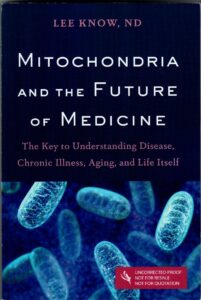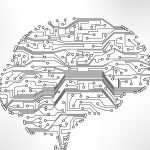Medical Resources for NDs: A Review of Current Publications for the Naturopathic Industry
Education
Mitochondria and the Future of Medicine: The Key to Understanding Disease, Chronic Illness, Aging, and Life Itself
Node Smith, ND
In a new book, Mitochondria and the Future of Medicine: The Key to Understanding Disease, Chronic Illness, Aging, and Life Itself, Lee Know, ND, pursues a much needed delve into the role of mitochondria in health and disease. The exploration is mapped out by Know in expert fashion, beginning with a foundational overview of mitochondrial physiology and cellular biology, continuing on with an account of mitochondrial dysfunction and their role in disease, and completing the book with a discussion of nutritional factors that promote mitochondrial function. The book is both easy to read and incredibly informative. The target audience is clearly healthcare professionals, though patients with a background knowledge of cellular biology and human physiology will also certainly benefit from reading it.
Dr Know clearly makes the case for supporting healthy mitochondrial function in an accessible 186 pages. The content is well researched and an extensive reference section is included at the end of the book; however, in-text references are lacking. Also, physicians who have a fairly good grasp of cellular biology and general mitochondrial function may skip the entire first chapter, “The Force.” It’s a great overview of cellular biology; however, each paragraph seems to include an attempt at humor which may be distracting for some readers.
In the second chapter, “The Dark Side of the Force” (Know compares mitochondria to the mitochlorians of Star Wars – a great analogy), the book settles into a nice flow of content and is difficult to put down. The basic functions of the mitochondria and how they impact multiple organ systems are fully elaborated, and multiple disease states are explored. The manner in which oxygen deprivation and ischemia impact ATP production, which likely underlies a pervasive chronic fatigue picture that is commonly seen clinically, is an excellent and astute association. Also, the consideration of mitochondria’s role in cardiovascular disease states and neurodegenerative diseases is a huge takeaway.
Perhaps the most overarching concept presented by Know is that mitochondrial health is perhaps the foundational component of the aging process. Though Know is clearly not writing for a specifically “anti-aging audience,” many of the principles of this growing area of medicine are clearly elucidated. A beneficial byproduct of this clarity may be that practitioners (and readers in general) can more easily sift through the “hype” around anti-aging products and supplements. The function of the mitochondria is of primary concern throughout the book, and this connection is not lost when addressing specific nutrients or lifestyle factors. Someone would not read this book and conclude that supplement X is the panacea for youth, but would obtain numerous tools for increasing the robustness of mitochondrial vitality.
The final chapter, “Nurturing the Force,” is an excellent resource for anyone interested in clinically supporting mitochondrial health. Dr Know walks through all of the nutrients that contribute to healthy mitochondrial functioning, which is actually a very accessible handful. In this chapter he goes on the assumption that the reader has read the rest of the book, and he does a great job of concisely presenting each nutrient and its impact, and without a ton of research studies (there are some) that can make chapters like this seem to drag on forever. Its understood that the supporting research is contained elsewhere in the book.
I would recommend this book to any and all healthcare practitioners who are interested in uncovering foundational causes of disease. It would also be a worthwhile investment of time and money for any medical student currently seeing patients. It’s certainly a “high yield” read. I would also recommend this book to any athlete that is serious about their health and athletic performance, as so much of the material in the book is immediately applicable to this population of individuals. In fact, the primary function of mitochondria – to create energy – makes athletes a natural audience.

- Title: Mitochondria and the Future of Medicine: The Key to Understanding Disease, Chronic Illness, Aging, and Life Itself
- Author: Lee Know, ND
- Publisher: Chelsea Green Publishing
- Available from: All major book sellers
- Pages: 243
- Style: Trade Paperback
- Copyright: 2018
- MSRP: $24.95
 Node Smith, ND, is a naturopathic physician in Portland, OR and associate editor for NDNR. He has been instrumental in maintaining a firm connection to the philosophy and heritage of naturopathic medicine among the next generation of docs. He helped found the first multi-generational experiential retreat, which brings elders, alumni, and students together for a weekend camp-out where naturopathic medicine and medical philosophy are experienced in nature. Four years ago he helped found the non-profit, Association for Naturopathic ReVitalization (ANR), for which he serves as the board chairman. ANR has a mission to inspire health practitioners to embody the naturopathic principles through experiential education. Node also has a firm belief that the next era of naturopathic medicine will see a resurgence of in-patient facilities which use fasting, earthing, hydrotherapy and homeopathy to bring people back from chronic diseases of modern living; he is involved in numerous conversations and projects to bring about this vision.
Node Smith, ND, is a naturopathic physician in Portland, OR and associate editor for NDNR. He has been instrumental in maintaining a firm connection to the philosophy and heritage of naturopathic medicine among the next generation of docs. He helped found the first multi-generational experiential retreat, which brings elders, alumni, and students together for a weekend camp-out where naturopathic medicine and medical philosophy are experienced in nature. Four years ago he helped found the non-profit, Association for Naturopathic ReVitalization (ANR), for which he serves as the board chairman. ANR has a mission to inspire health practitioners to embody the naturopathic principles through experiential education. Node also has a firm belief that the next era of naturopathic medicine will see a resurgence of in-patient facilities which use fasting, earthing, hydrotherapy and homeopathy to bring people back from chronic diseases of modern living; he is involved in numerous conversations and projects to bring about this vision.










